|
|
|
Sort Order |
|
|
|
Items / Page
|
|
|
|
|
|
|
| Srl | Item |
| 1 |
ID:
110865
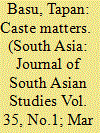

|
|
|
| 2 |
ID:
110864
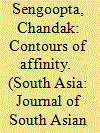

|
|
|
|
|
| Publication |
2012.
|
| Summary/Abstract |
This paper seeks to demonstrate the complexities of the Tagorean legacy through a re-examination of Tagore's influence on the filmmaker Satyajit Ray. Reappraising Ray's brief period at Santiniketan and some of his most celebrated engagements with Tagore, the essay argues that contrary to conventional wisdom, Ray was not a wholehearted follower of Tagore but a critical and creative interlocutor. The nuanced interpretation of his relationship with Tagore that Ray himself proffered in his last film Agantuk (1991), the essay suggests, is more persuasive than the exaggerated notions of Ray's Tagoreanism propagated by the vast majority of his biographers and critics.
|
|
|
|
|
|
|
|
|
|
|
|
|
|
|
|
| 3 |
ID:
110861
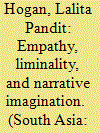

|
|
|
|
|
| Publication |
2012.
|
| Summary/Abstract |
This essay focuses on the motif of symbolic death in Rabindranath Tagore's'The Living and the Dead' to explore how social injustices occur when empathy for an individual (or a group) is blocked. Arnold Van Gennep's notion of pre-liminal, liminal and post-liminal rites of passage that situate humans in efficacious, productive social relations, is used to contextualise the liminality motif in appropriate theoretical terms, while the introductory and ending references to Martha Nussbaum's idea that literary texts serve to unblock empathy (for the reader), by making invisible pain and suffering visible, draw attention to Tagore's contribution to this kind of humanising literature, and his relevance as an important literary figure in today's world.
|
|
|
|
|
|
|
|
|
|
|
|
|
|
|
|
| 4 |
ID:
110866
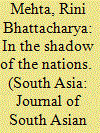

|
|
|
|
|
| Publication |
2012.
|
| Summary/Abstract |
This essay revisits the political persona of Rabindranath Tagore (1861-1941) in the period following his receiving the Nobel Prize in Literature in 1913. While Tagore's political voice in Bengal and India had already been radicalised in 1908 with his unequivocal rejection of British imperialism and militant Indian nationalism, he would formulate his mature critique of the 'nation' only during his post-Nobel visit to Japan and the United States in 1916. To the reader who could access Tagore's works only in English translation, there is a world of difference between the poet of The Gitanjali and the author of Nationalism. This essay revisits the contexts of that difference.
|
|
|
|
|
|
|
|
|
|
|
|
|
|
|
|
| 5 |
ID:
110857
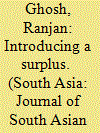

|
|
|
| 6 |
ID:
110862
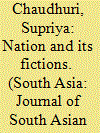

|
|
|
|
|
| Publication |
2012.
|
| Summary/Abstract |
In Rabindranath Tagore's novel Gora (1910) and Salman Rushdie's Midnight's Children (1981), literary works which employ the fiction of nativity to examine a paradoxical moment of historical origin, the idea of the nation is subjected to intolerable strain. Fables of identity are constructed in both novels, yet instead of a 'hardening' of the metaphysical idea that sustains the allegorical parallel, what we witness is a radical dissolution or disintegration of the categories of nation and narrative at the very site of their inscription. I will argue that in both works, the symbolic equation of novel and nation opens up fissures in historical experience.
|
|
|
|
|
|
|
|
|
|
|
|
|
|
|
|
| 7 |
ID:
110859
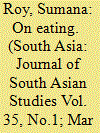

|
|
|
|
|
| Publication |
2012.
|
| Summary/Abstract |
The Tagore family had as much influence on the fine arts, music, dance, clothing and architecture as they did on Bengali cuisine. Rabindranath Tagore, born after the experiments in the bawarcheekhana (kitchen) during Dwarkanath's time and Debendranath's culture of frugal but balanced nutritious meals, was exposed to European cuisine during his visits abroad and by Jnadanandini, his sister-in-law. In this paper, I try to show, against a background of the assimilative tendencies of the Thakurbari (the Tagore household) kitchen, how Tagore's use of gastronomic tropes was at odds with his theory of internationalism, and how they are used, with their positive biases and prejudices, as cultural and category markers to differentiate Tagore's great binary of the East and West.
|
|
|
|
|
|
|
|
|
|
|
|
|
|
|
|
| 8 |
ID:
110858
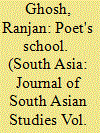

|
|
|
|
|
| Publication |
2012.
|
| Summary/Abstract |
This paper looks into the dynamics and performatives of Tagore's school which was established in 1901 at Bolpur in West Bengal. He called it Santiniketan. The paper critiques Tagore's notions of pedagogy in relation to the pregnant network linking the students, teachers and their natural environment; further, it investigates how the school has manifested itself as a green discourse and worked itself out within the dialectic of space and place, giving Tagore's ideas and the pragmatics of execution a fresh circulation of understanding. Here, for the first time, Tagore's ideas on education and nature (eco-pedagogy) are elaborately problematised through the intersections of a variety of thoughts and concepts drawn from contemporary ecocritical studies, ecosophy, discourses on nature, culture, and ethics of humane holism and bioegalitarianism.
|
|
|
|
|
|
|
|
|
|
|
|
|
|
|
|
| 9 |
ID:
110863
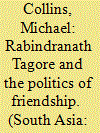

|
|
|
|
|
| Publication |
2012.
|
| Summary/Abstract |
Caught between an arrogant European modernist elite and a proprietorial Indian nationalism, Tagore challenged the spatial dimensions of modernity by critiquing both Eurocentrism and a simplistic anti-imperialism. Tagore did build bridges with some Western intellectuals and social activists but much of his life illustrates the difficulties of meaningful cross-cultural relations and the shortcomings of a liberal 'politics of friendship'. If this is in part due to the inadequacy of translation, then we need more and better translations. Rather than resurrecting a platitudinous 'cosmopolitan' World Citizen, Tagore's work should require us to think more critically about parallel modernities and different ways of imagining our futures. As China and India, perhaps above all others, grow in economic, political and cultural strength, these questions are likely to become more pressing.
|
|
|
|
|
|
|
|
|
|
|
|
|
|
|
|
| 10 |
ID:
110860
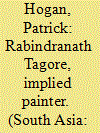

|
|
|
|
|
| Publication |
2012.
|
| Summary/Abstract |
This essay examines the idea of implied authorship in relation to painting. It considers a painting by Tagore, arguing that enigmas in the painting may be partially resolved by reference to ideas from a range of Tagore's works. This suggests that, beyond the implied author of a particular work, we should consider the implied author across a canon of works. This canonical implied author does not substitute for the implied author of an individual work. However, it provides one important context for interpretation. Moreover, it does not render the work unequivocal, but alters the profile of ambiguity of the work.
|
|
|
|
|
|
|
|
|
|
|
|
|
|
|
|
|
|
|
|
|